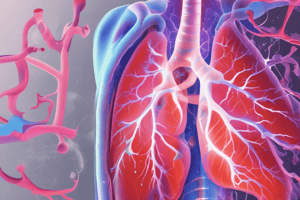Podcast
Questions and Answers
Which of the following disorders are considered acute intrinsic pulmonary disorders?
Which of the following disorders are considered acute intrinsic pulmonary disorders?
- Infectious pneumonia (correct)
- Pulmonary edema (correct)
- Pneumothorax
- Interstitial lung diseases
Which of the following are extrinsic restrictive pulmonary disorders?
Which of the following are extrinsic restrictive pulmonary disorders?
- Aspiration pneumonitis
- Pleural effusions (correct)
- Mediastinal masses (correct)
- Arterial blood gases
What happens to the total lung capacity (TLC) in restrictive pulmonary disease?
What happens to the total lung capacity (TLC) in restrictive pulmonary disease?
Decreased
The FV Loop in restrictive pulmonary disease shows a ______ pattern.
The FV Loop in restrictive pulmonary disease shows a ______ pattern.
In restrictive pulmonary disease, FEV1/FVC is typically decreased.
In restrictive pulmonary disease, FEV1/FVC is typically decreased.
What is a clinical feature of restrictive pulmonary disease?
What is a clinical feature of restrictive pulmonary disease?
What is the recommended tidal volume for ventilation in patients with acute intrinsic pulmonary disorders?
What is the recommended tidal volume for ventilation in patients with acute intrinsic pulmonary disorders?
Flashcards are hidden until you start studying
Study Notes
Restrictive Pulmonary Disease Overview
- Characterized by decreased lung volumes and reduced lung expansion
- Can be caused by intrinsic lung disorders or extrinsic factors affecting the chest wall, pleura, or neuromuscular function
- Gas exchange usually remains normal until the disease is advanced
Types of Restrictive Pulmonary Disease
- Acute Intrinsic Pulmonary Disorders
- Pulmonary edema, including acute respiratory distress syndrome (ARDS)
- Infectious pneumonia
- Aspiration pneumonitis
- Chronic Intrinsic Pulmonary Disorders
- Interstitial lung diseases
- Extrinsic Restrictive Pulmonary Disorders
- Pleural effusions
- Pneumothorax
- Mediastinal masses
- Kyphoscoliosis
- Pectus excavatum
- Neuromuscular disorders
- Increased intraabdominal pressure from ascites, pregnancy, or bleeding
- Marked obesity
Clinical Features
- Dyspnea on exertion
- Nonproductive cough
- Symptoms of cor pulmonale only with advanced disease
Diagnostic Tests
- Spirometry
- FEV1/FVC is normal or increased
- FEV1, FVC decreased
- FV Loop shows a "witch's hat" pattern
- Lung Volumes
- TLC and RV are decreased
- Lung compliance is decreased
- DLCO
- Decreased
Chest Radiograph
- Progression from "ground-glass" appearance to prominent reticulonodular markings, and finally, to a "honeycomb" appearance
Arterial Blood Gases
- Mild hypoxemia with normocarbia
PFTs
- Typical of a restrictive ventilatory defect
Management of Acute Intrinsic Pulmonary Disorders
- Elective surgery should be postponed
- Optimize oxygenation and ventilation preoperatively
- Treat fluid overload with diuretics
- Consider drainage of large pleural effusions
- Relieve massive abdominal distention with nasogastric compression or drainage of ascites
- Persistent hypoxemia may require mechanical ventilation
Anesthesia Management
- Intravenous and inhalation agents combined with a neuromuscular blocking agent
- Decreased lung compliance increases the risk of barotrauma and volutrauma during positive-pressure ventilation
Ventilator Strategy
- Tidal volume: 4-6 mL/kg
- Respiratory rate: 14–18 breaths/min
- Airway pressure: no more than 30 cm H2O
- PEEP: High may be needed with caution
- FiO2: High
Airway Pressure Release Ventilation (APRV)
- May improve oxygenation in patients with ARDS
- Superior to conventional ventilation modes
- Reduces peak airway pressure without compromising oxygenation
- Promotes alveolar recruitment and improves oxygenation
- Allows for spontaneous breathing
- Improves V/Q matching and oxygenation in severe ARDS
- Allows for less sedation, improved cardiopulmonary function, and decreased time on ventilators
Studying That Suits You
Use AI to generate personalized quizzes and flashcards to suit your learning preferences.


